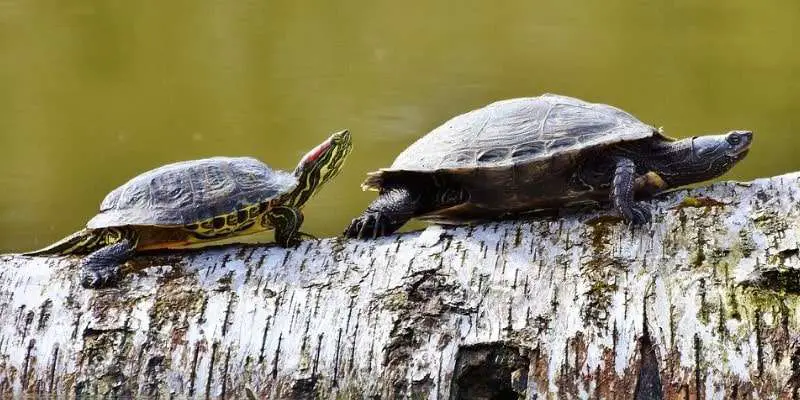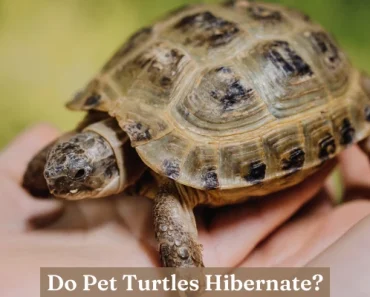
Most people don’t think of a question like this, but I guess I’m different. Maybe you are too, otherwise, you wouldn’t be reading this. So I guess we both think alike.
I think of many questions not many others think about. But for today, I am going to discuss the question, “Where do turtles go in the winter?” and provide you with a very detailed and awesome answer to that question and a few related questions.
I guess one of the main reasons I think of questions like this is because I have a turtle in the family. His name is “Lil Buddy” (red-eared slider) and he loves some small minnows to munch on.
If you have a turtle in the family like me, then maybe it is easier for you to think of questions like this as well. The whole “out of sight, out of mind” cliche is true for most people regarding this question I imagine.
Regardless of why or how you found your way here, let’s talk about some turtle stuff.
Are you ready? I am! I just had my 10 cups of coffee for today, so let’s do this!
Where do turtles go in the winter?
Terrestrial and aquatic turtles differ in how they avoid the cold in the winter. Terrestrial turtles burrow beneath soft soil on land to keep from freezing in the winter while aquatic turtles burrow into the soft mud in ponds and riverbanks where they remain throughout the winter months.
Terrestrial turtles burrow into the ground where they find soft enough soil and remain there all winter, not moving, not making phone calls, no social media, none of that.:)
They do not eat or drink either during this time. They don’t need to because the cool temperature helps slow down their metabolism enough to survive all winter without food and water.
Aquatic turtles dig down into the soft mud of lakes and ponds where they will also remain motionless the entire winter. Their metabolism is slowed by the cool temperature as well.

How do aquatic turtles breathe underwater?
Continuing from above, I imagine a question that you would think of next is how do aquatic turtles breathe underwater ALL winter?
Since their metabolism slows down from the cool temperature, they need very little to almost no oxygen to breathe. What oxygen they do need to breathe comes from what little stored energy they have.
Many aquatic turtles exchange enough oxygen and carbon dioxide with the water through their skin and tissues in their throat and tail to survive all winter without oxygen from the surface.
This keeps them from needing to go topside for oxygen the entire winter, They don’t move during the winter while they are burrowed.
If they could move and wanted to reach the water surface during winter, they would be out of luck in most cases. The surface of the water in many lakes and ponds would be frozen, not allowing the turtle to reach the surface to breathe.
So it’s a good thing they can just sit there and be still and Hakuna Matata or whatever they decide to do.
What about marine and tropical turtles?
Since these turtles are never exposed to the cold, they do not have to worry about burrowing underground to stay warm.
Their climate stays warm all year round, so they remain active all year round.

How cold is too cold for a turtle?
As an ectotherm, turtles rely on outside sources to keep their body warm. Their internal heat source is very small and is of little significance in keeping the turtle’s body temperature at a survivable rate during the cold winter months.
Too cold for a turtle is between 40 to 50 degrees.
For many turtles, if the temperature falls below 50 degrees in the climate where the turtle resides, it will find shelter in a burrow either underground or in the mud of a lake or pond until the cold months are over, which can be 3 to 4 months depending on the region.
Can a turtle freeze to death?
Yes, a turtle can freeze to death.
As mentioned above, if the temperature falls below 40 degrees, there is a good chance the turtle will freeze to death.
This is why most turtles burrow into the ground or mud. By burrowing into the ground and remaining inactive, turtles can keep their body temperature from falling below freezing helping them survive until winter is over.
How do baby turtles survive the winter?
Many different turtles lay their eggs in the sand or by digging a hole in the dirt and covering the nest back up after laying their eggs.
Most of these eggs start to hatch around autumn before the really cold months start. So you think they would high-tail it out of there and get to somewhere else warm right?
No, they don’t. Most babies will stay buried snug in the nest until the following spring.
It makes sense for them to just stay put where they are already in a good spot to keep their body temperature regulated throughout the winter.
Final Thoughts
I would just like to point out that there are hundreds of different species of turtles and not all will follow the same pattern.
This is a general guide to the majority of the terrestrial, aquatic, and tropical turtles, but may not apply to every single turtle species on the planet.
That said, you should have a pretty good idea of how most wild turtles survive the winter now. It is an amazing feat to practically not breathe for many months while not moving during the entire winter.
I know they don’t think like us, but I just can’t imagine having to sit still in one place for almost 4 months. Talk about one serious time-out and you didn’t even do anything to deserve it!
Well, that is all I have, for now, my fellow turtle lovers!
I hope you learned everything you needed to know and then some about where turtles go in the winter. I can’t wait to get another turtle subject to write about soon and hope you will come back to give it a read.
If you liked this article, these articles may also interest you.
Don’t forget to like or share, check out other articles, and have a wonderful day!




